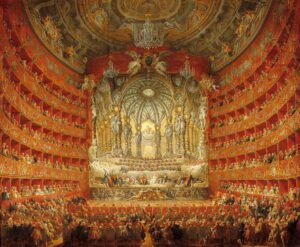 |
| Fête musicale. Oil on canvas by Giovanni Paolo Pannini, 1747. Louvre Museum. Via Wikimedia. |
In 1597 when Jacopo Peri composed Dafne, the first opera ever written, sporadic epidemics of bubonic plague were still striking his city of Florence. Venice was also suffering greatly. It had been visited by the plague twenty-two times, and some 50,000 of its people had died in 1576.
The plague affected predominantly the poor in the crowded cities, while the wealthy could seek refuge in their country villas. However, from being exclusively an aristocratic entertainment, opera soon became popular with wider audiences. In 1637, Claudio Monteverdi witnessed the opening of the first public opera house in Venice, the San Cassiano. It caused a new burst of energy in his life, and he revised several operas he had written before and also wrote new ones, notably L’incoronazione di Poppea. By the time of his death in 1643 at age seventy-six, opera had become a major form of entertainment for the public. Great composers followed: Domenico Scarlatti (1685–1757) and George Frideric Handel (1685–1759). In time two types of opera emerged: opera seria, tragic, and opera buffa, comical and entertaining.
But medicine also underwent a transformation. In Vienna, the empress Maria Theresia became a dedicated promoter of medical education and science. She appointed the Dutchman Gerard van Swieten to create the first teaching hospital, introducing regular instruction in anatomy and dissection, mandating clinical instruction at the bedside, and emphasizing a healthy diet and hygienic regimens instead of the absurd polypharmacy then in vogue.
The enlightened Joseph II continued his mother’s policies. In Vienna and also in Venice (soon to become a dependency of the Habsburg empire), opera became a grand spectacle, with elaborate sets, costumes, and staging techniques. Wolfgang Amadeus Mozart’s masterpieces The Marriage of Figaro (1786) and Don Giovanni (1787) raised the appreciation of opera to an even higher level. The bel canto composers Rossini, Bellini, and Donizetti followed, then Giuseppe Verdi with Rigoletto (1851) and Traviata and Trovatore (both 1853), as well as Richard Wagner with his revolutionary Singspiel, exemplified by Tristan und Isolde (1865) and The Ring Cycle (1876).
In medicine progress was at first slower. It remained mired in old traditions and beliefs until the advances of Louis Pasteur, the antiseptic surgery of Joseph Lister, and later by aseptic surgery. The great revolution occurred when Robert Koch and several others discovered that most illnesses were caused by bacteria and parasites. Yet the real breakthrough did not occur until the discovery of penicillin by Alexander Fleming and its purification by Howard Florey and Ernst Boris Chain.
Streptomycin arrived in 1950 and revolutionized the treatment of tuberculosis. No longer did the successors of the operatic heroines Mimi and Violeta need to die young. Then in the twentieth century, opera and medicine continued on their parallel paths. Grand opera became immensely popular, performed in exquisite opera houses lined with purple and gold. Enrico Caruso sang there, as did Beniamino Gigli, Jussi Björling, and their tenor successors, and so did Dame Nellie Melba, Amelita Galli-Curci, Kirsten Flagstad, and Maria Callas.
In medicine great advances and incredible innovations revolutionized diagnosis, surgical treatment, and therapeutics. Only the viruses have remained undefeated, causing epidemics such as influenza, polio, SARS, HIV, and most recently COVID-19.
Opera is also benefiting from the many advances in technology. Its audiences seem to be changing. Much of the elegance of an evening at the opera seems to be no more. Gone also are the days when impecunious youths would faint in standing room while listening to the interminable Ring of the Nibelungs. They now attend in comfortable seats, if they attend at all.
The libretti are also changing. Fierce noblemen no longer fight deadly duels. The quack who peddled his wares to unsuspecting villagers in the Elisir d’Amore has been replaced by fraud on a much larger scale. There is more bureaucracy, more regulation, and more stringent credentialing. Was the pompous Doctor Bartolo in the Barber of Seville a physician with a valid medical license? Or was he perhaps a professor of education or ethics? We do not know. Rossini only tells us that he locked up his young ward against her will and intended to marry her.
GEORGE DUNEA, MD, Editor-in-Chief

Leave a Reply